+ Open data
Open data
- Basic information
Basic information
| Entry | Database: PDB / ID: 1ff5 | ||||||
|---|---|---|---|---|---|---|---|
| Title | STRUCTURE OF E-CADHERIN DOUBLE DOMAIN | ||||||
 Components Components | EPITHELIAL CADHERIN | ||||||
 Keywords Keywords | CELL ADHESION / E-cadherin / Ca-binding | ||||||
| Function / homology |  Function and homology information Function and homology informationuterine epithelium development / Apoptotic cleavage of cell adhesion proteins / desmosome assembly / salivary gland cavitation / regulation of branching involved in salivary gland morphogenesis / Adherens junctions interactions / RHO GTPases activate IQGAPs / Degradation of the extracellular matrix / Integrin cell surface interactions / positive regulation of cell-cell adhesion ...uterine epithelium development / Apoptotic cleavage of cell adhesion proteins / desmosome assembly / salivary gland cavitation / regulation of branching involved in salivary gland morphogenesis / Adherens junctions interactions / RHO GTPases activate IQGAPs / Degradation of the extracellular matrix / Integrin cell surface interactions / positive regulation of cell-cell adhesion / desmosome / lateral loop / regulation of protein localization to cell surface / alpha-catenin binding / trophectodermal cell differentiation / calcium-dependent cell-cell adhesion / bicellular tight junction assembly / flotillin complex / intestinal epithelial cell development / cell-cell adhesion mediated by cadherin / Schmidt-Lanterman incisure / catenin complex / epithelial cell morphogenesis / regulation of neuron migration / node of Ranvier / negative regulation of protein processing / apical junction complex / microvillus / homophilic cell-cell adhesion / decidualization / cochlea development / canonical Wnt signaling pathway / establishment of skin barrier / negative regulation of protein localization to plasma membrane / cytoskeletal protein binding / positive regulation of protein localization / axon terminus / embryo implantation / cell periphery / protein localization to plasma membrane / adherens junction / cellular response to amino acid stimulus / sensory perception of sound / negative regulation of canonical Wnt signaling pathway / cell-cell adhesion / beta-catenin binding / apical part of cell / negative regulation of epithelial cell proliferation / cell-cell junction / regulation of protein localization / regulation of gene expression / actin cytoskeleton organization / protein phosphatase binding / basolateral plasma membrane / in utero embryonic development / molecular adaptor activity / endosome / protein domain specific binding / axon / calcium ion binding / cell surface / Golgi apparatus / identical protein binding / plasma membrane / cytoplasm Similarity search - Function | ||||||
| Biological species |  | ||||||
| Method |  X-RAY DIFFRACTION / Resolution: 2.93 Å X-RAY DIFFRACTION / Resolution: 2.93 Å | ||||||
 Authors Authors | Pertz, O. / Bozic, D. / Koch, A.W. / Fauser, C. / Brancaccio, A. / Engel, J. | ||||||
 Citation Citation |  Journal: EMBO J. / Year: 1999 Journal: EMBO J. / Year: 1999Title: A new crystal structure, Ca2+ dependence and mutational analysis reveal molecular details of E-cadherin homoassociation. Authors: Pertz, O. / Bozic, D. / Koch, A.W. / Fauser, C. / Brancaccio, A. / Engel, J. | ||||||
| History |
|
- Structure visualization
Structure visualization
| Structure viewer | Molecule:  Molmil Molmil Jmol/JSmol Jmol/JSmol |
|---|
- Downloads & links
Downloads & links
- Download
Download
| PDBx/mmCIF format |  1ff5.cif.gz 1ff5.cif.gz | 103.4 KB | Display |  PDBx/mmCIF format PDBx/mmCIF format |
|---|---|---|---|---|
| PDB format |  pdb1ff5.ent.gz pdb1ff5.ent.gz | 78.8 KB | Display |  PDB format PDB format |
| PDBx/mmJSON format |  1ff5.json.gz 1ff5.json.gz | Tree view |  PDBx/mmJSON format PDBx/mmJSON format | |
| Others |  Other downloads Other downloads |
-Validation report
| Summary document |  1ff5_validation.pdf.gz 1ff5_validation.pdf.gz | 375.3 KB | Display |  wwPDB validaton report wwPDB validaton report |
|---|---|---|---|---|
| Full document |  1ff5_full_validation.pdf.gz 1ff5_full_validation.pdf.gz | 388.4 KB | Display | |
| Data in XML |  1ff5_validation.xml.gz 1ff5_validation.xml.gz | 11.5 KB | Display | |
| Data in CIF |  1ff5_validation.cif.gz 1ff5_validation.cif.gz | 18.5 KB | Display | |
| Arichive directory |  https://data.pdbj.org/pub/pdb/validation_reports/ff/1ff5 https://data.pdbj.org/pub/pdb/validation_reports/ff/1ff5 ftp://data.pdbj.org/pub/pdb/validation_reports/ff/1ff5 ftp://data.pdbj.org/pub/pdb/validation_reports/ff/1ff5 | HTTPS FTP |
-Related structure data
| Related structure data | |
|---|---|
| Similar structure data |
- Links
Links
- Assembly
Assembly
| Deposited unit | 
| ||||||||
|---|---|---|---|---|---|---|---|---|---|
| 1 |
| ||||||||
| Unit cell |
|
- Components
Components
| #1: Protein | Mass: 23919.590 Da / Num. of mol.: 2 / Fragment: DOUBLE DOMAIN Source method: isolated from a genetically manipulated source Source: (gene. exp.)   #2: Chemical | ChemComp-CA / #3: Water | ChemComp-HOH / | |
|---|
-Experimental details
-Experiment
| Experiment | Method:  X-RAY DIFFRACTION / Number of used crystals: 1 X-RAY DIFFRACTION / Number of used crystals: 1 |
|---|
- Sample preparation
Sample preparation
| Crystal | Density Matthews: 6.92 Å3/Da | ||||||||||||||||||||||||||||||||||||||||||||||||||||||
|---|---|---|---|---|---|---|---|---|---|---|---|---|---|---|---|---|---|---|---|---|---|---|---|---|---|---|---|---|---|---|---|---|---|---|---|---|---|---|---|---|---|---|---|---|---|---|---|---|---|---|---|---|---|---|---|
| Crystal grow | Temperature: 298 K / Method: vapor diffusion, hanging drop / pH: 8.5 Details: 50 mM ammonium sulfate, 50 mM NaOAc, 30% PEG 8000, pH 8.5, Tris-HCl, VAPOR DIFFUSION, HANGING DROP, temperature 298.0K | ||||||||||||||||||||||||||||||||||||||||||||||||||||||
| Crystal | *PLUS Density % sol: 58 % | ||||||||||||||||||||||||||||||||||||||||||||||||||||||
| Crystal grow | *PLUS pH: 7.4 | ||||||||||||||||||||||||||||||||||||||||||||||||||||||
| Components of the solutions | *PLUS
|
-Data collection
| Diffraction | Mean temperature: 298 K |
|---|---|
| Diffraction source | Source:  ROTATING ANODE / Type: ELLIOTT GX-20 / Wavelength: 1.5418 ROTATING ANODE / Type: ELLIOTT GX-20 / Wavelength: 1.5418 |
| Detector | Type: MARRESEARCH / Detector: AREA DETECTOR |
| Radiation | Protocol: SINGLE WAVELENGTH / Monochromatic (M) / Laue (L): M / Scattering type: x-ray |
| Radiation wavelength | Wavelength: 1.5418 Å / Relative weight: 1 |
| Reflection | Resolution: 2.93→20 Å / Num. all: 28520 / Num. obs: 28520 / % possible obs: 95.5 % / Rmerge(I) obs: 0.133 |
| Reflection | *PLUS Num. obs: 13451 / Num. measured all: 28520 |
| Reflection shell | *PLUS Highest resolution: 2.93 Å / Lowest resolution: 3 Å / % possible obs: 81.5 % |
- Processing
Processing
| Software |
| ||||||||||||||||||
|---|---|---|---|---|---|---|---|---|---|---|---|---|---|---|---|---|---|---|---|
| Refinement | Resolution: 2.93→20 Å / Rfactor all: 0.1986 / σ(F): 0 / Stereochemistry target values: Engh & Huber | ||||||||||||||||||
| Refinement step | Cycle: LAST / Resolution: 2.93→20 Å
| ||||||||||||||||||
| Refine LS restraints |
| ||||||||||||||||||
| Software | *PLUS Name:  X-PLOR / Version: 3.1 / Classification: refinement X-PLOR / Version: 3.1 / Classification: refinement | ||||||||||||||||||
| Refinement | *PLUS Lowest resolution: 20 Å / σ(F): 0 | ||||||||||||||||||
| Solvent computation | *PLUS | ||||||||||||||||||
| Displacement parameters | *PLUS | ||||||||||||||||||
| Refine LS restraints | *PLUS Type: x_bond_d / Dev ideal: 0.01 |
 Movie
Movie Controller
Controller







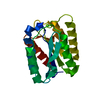
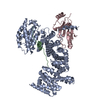

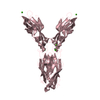
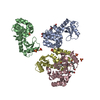


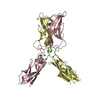
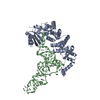
 PDBj
PDBj



